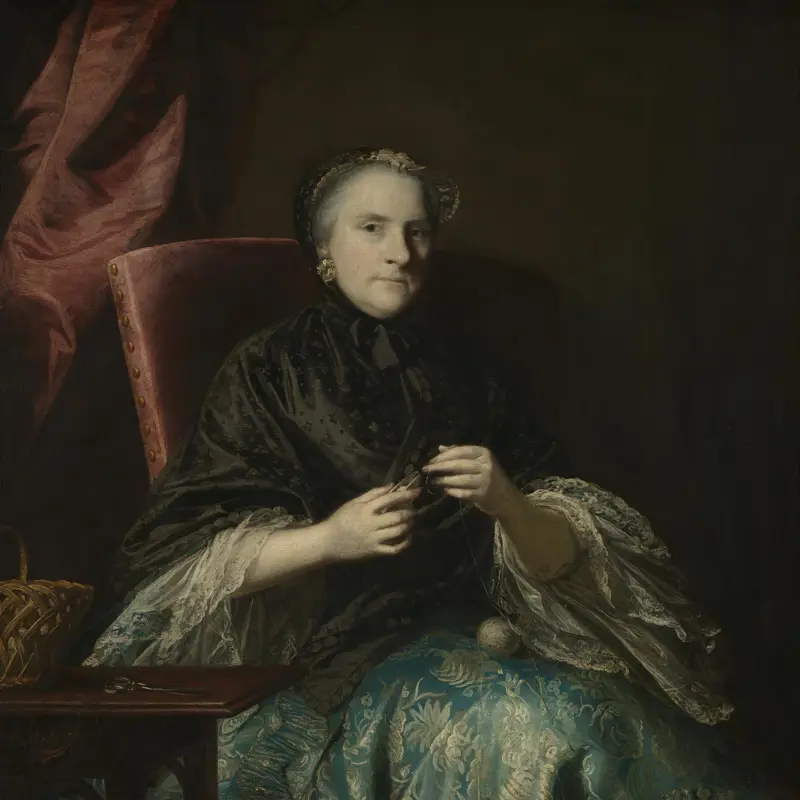Sir Joshua Reynolds, 'Captain Robert Orme', 1756
About the work
Overview
This portrait shows Captain Robert Orme (1725–90) at the age of 31, during the war against the French for supremacy in the North American colonies. Reynolds painted it on speculation in the hope of selling it or displaying it to gain more work.
Orme was aide-de-camp to General Edward Braddock, commander-in-chief of the British forces in America, and was friends with the young George Washington. On 9 July 1755, General Braddock and his forces were ambushed and defeated by French and Native American riflemen near Fort Du Quesne on the Ohio River. In Reynolds’s portrait, Orme seems about to leap on his horse and ride off with reports of the battle. The dispatch he holds is illegible but may carry news of Braddock’s death. The poses of Orme and his horse are derived from a fresco by Jacopo Ligozzi in the church of Ognissanti in Florence, which Reynolds drew in 1752 in his Italian sketchbook.
Key facts
Details
- Full title
- Captain Robert Orme
- Artist
- Sir Joshua Reynolds
- Artist dates
- 1723 - 1792
- Date made
- 1756
- Medium and support
- Oil on canvas
- Dimensions
- 239 × 147 cm
- Inscription summary
- Signed; Dated
- Acquisition credit
- Bought, 1862
- Inventory number
- NG681
- Location
- Room 34
- Collection
- Main Collection
- Frame
- 18th-century English Frame
Provenance
Additional information
Text extracted from the ‘Provenance’ section of the catalogue entry in Judy Egerton, ‘National Gallery Catalogues: The British Paintings’, London 2000; for further information, see the full catalogue entry.
Bibliography
-
1755'Braddock's Defeat', Gentleman's Magazine, 1755
-
1755London, British Library, King's MSS.212: R. Orme, Robert Orme's Journal, 20 February 1755 - 13 July 1755
-
1790'Orme's Obituary', Gentleman's Magazine, 1790
-
1801London, Public Record Office, ROB 11/1197: R. Orme, Robert Orme's Will, 1801
-
1818J. Northcote, The Life of Sir Joshua Reynolds, London 1818
-
1833D. Mackinnon, Origins and Services of the Coldstream Guards, London 1833
-
1855W. Sargent, 'History of the Expedition Against Fort Du Quesne in 1755', Memoirs of the Historical Society of Pennsylvania, V, 1855, pp. 358-9
-
1860British Institution, Catalogue of the Works of British Artists in the Gallery of the British Institution, Pall Mall, for Exhibition and Sale, London 1860
-
1899A. Graves and W.V. Cronin, A History of the Works of Sir Joshua Reynolds P.R.A., 4 vols, London 1899
-
1926E. Sherson, The Lively Lady Townsend and Her Friends, London 1926
-
1928W.T. Whitley, Artists and their Friends in England 1700-1799, London 1928
-
1932L.M. Sears, George Washington, New York 1932
-
1937W.S. Lewis et al. The Yale Edition of Horace Walpole's Correspondence, 48 vols, New Haven 1937
-
1938H. Gatty, 'Notes by Horace Walpole Fourth Earl of Orford, on the Exhibitions of the Society of Artists and the Free Society of Artists, 1760-91', The Walpole Society, XVIII, 1939, pp. 55-88
-
1946Davies, Martin, National Gallery Catalogues: British School, London 1946
-
1948D.S. Freeman, George Washington, London 1948
-
1959Davies, Martin, National Gallery Catalogues: British School, 2nd edn (revised), London 1959
-
1968M. Cormack, 'The Ledgers of Sir Joshua Reynolds', The Walpole Society, XLII, 1970, pp. 105-69
-
1973E.K. Waterhouse, Reynolds, New York 1973
-
1976H. Potterton, Reynolds and Gainsborough, Themes and Painters in the National Gallery 2, London 1976
-
1976D. Mannings, 'Letter: Reynolds's "Captain Orme"', The Burlington Magazine, CXVIII, 1976
-
1976H. Potterton, 'Reynolds's Portrait of Captain Robert Orme in the National Gallery', The Burlington Magazine, CXVIII/875, 1976, pp. 104-6
-
1989N. Pevsner and B. Cherry, Buildings of England: Devon, London 1989
-
1990R. Prochno, Joshua Reynolds, Weinheim 1990
-
1994E. Langmuir, The National Gallery Companion Guide, London 1994
-
1995R. White and J. Pilc, 'Analyses of Paint Media', National Gallery Technical Bulletin, XVI, 1995, pp. 85-95
-
1998J. Egerton, The British School, London 1998
-
1999B. Bainbridge, 'Picture Choice', National Gallery News, 1999
-
2000Egerton, Judy, National Gallery Catalogues: The British Paintings, revised edn, London 2000
-
2001
C. Baker and T. Henry, The National Gallery: Complete Illustrated Catalogue, London 2001
-
2005Joshua Reynolds e l'invenzione della celebrità, Ferrara 2005
Frame
Dating from the mid-eighteenth century, this English carved and gilt frame is crafted from pinewood. The back edge is embellished with a semi-flower and leaf pattern. The pierced centre and corner cartouches feature a convex roundel in the middle encircled with gadroons, while the intermediate cartouches display a sunflower motif. The moulding is adorned with foliate strapwork, alongside shell and flower motifs. This is set against a punch-tooled background, which is only faintly visible, as it has been covered up by the regilding process. This leads to the sanded flat, before a French acanthus-leaf design at the sight edge. The frame was probably originally water-gilded, and subsequently oil-gilded.
Former Director Michael Levy stated that it was made between 1960 and 1962 from ‘strips’, referring to dismantled frame mouldings. The frame was adjusted for this painting, and the enlargement of the rebate is clearly visible on the back. A pencil note describes its previous location: ‘Left of [illegible] window 1 ft from dado top.’ Additionally, there is an exhibition label from the Royal Academy of Arts: ‘Sir Joshua Reynolds, Captain Orme, National Gallery, [no date provided]’.
About this record
If you know more about this work or have spotted an error, please contact us. Please note that exhibition histories are listed from 2009 onwards. Bibliographies may not be complete; more comprehensive information is available in the National Gallery Library.





